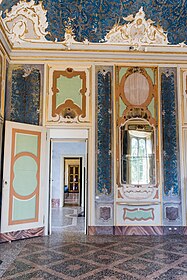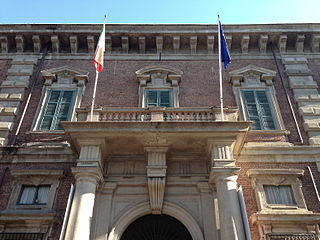
Palazzo Brera or Palazzo di Brera is a monumental palace in Milan, in Lombardy in northern Italy. It was a Jesuit college for two hundred years. It now houses several cultural institutions including the Accademia di Brera, the art academy of the city, and its gallery, the Pinacoteca di Brera; the Orto Botanico di Brera, a botanical garden; an observatory, the Osservatorio Astronomico di Brera; the Istituto Lombardo Accademia di Scienze e Lettere, a learned society; and an important library, the Biblioteca di Brera.

Brianza is a geographical, historical and cultural area of Italy, at the foot of the Alps, in the northwest of Lombardy, between Milan and Lake Como.

The University of Insubria is an Italian university located in Como and Varese, with secondary locations in Busto Arsizio and Saronno. It was founded in 1998, it has been named after the area where it is situated, the historical-geographical region of Insubria.

The Ghislieri College, founded in 1567 by Pope Pius V, is the second-oldest college in Pavia and co-founder of the IUSS in Pavia as well.

Palazzo Lombardia is a complex of buildings in Milan, Italy, including a 43-storey, 161 m (528 ft) tall skyscraper.
It is the main seat of the Lombardy regional government, located in the Centro Direzionale di Milano, north-west of the city centre.

The Natural History Museum in Pavia, Italy is a museum displaying many natural history specimens, located in Palazzo Botta Adorno. Founded in 1775, it was one of the oldest museums of natural history in Europe. It currently forms the University of Pavia museum network, along with 5 other museums — the University History Museum, Museum of Electrical Technology, Museum of Archeology, Museum Camillo Golgi and Museum of Mineralogy.
Cherubino Cornienti was an Italian painter, active in a Romantic style mainly in Northern Italy.

Giuseppe Amisani was an Italian portrait painter of the Belle Époque.
Fausto Cuocolo was an Italian jurist and politician. Cuocolo was amongst the most important Italian constitutionalist and one of the "fathers" of the Italian regionalism.

Santa Maria in Brera was a church in Milan, in Lombardy in northern Italy. It was built by the Humiliati between 1180 and 1229, given a marble façade and Gothic portal by Giovanni di Balduccio in the fourteenth century, and deconsecrated and partly demolished under Napoleonic rule in the early nineteenth century. The Napoleonic rooms of the Pinacoteca di Brera occupy the upper floor of what was the nave.

The Arese are a prominent family of the Milanese nobility.
Giuseppe Mariani was an Italian dermatologist and medical researcher. During World War I he received the Silver Medal of Military Valor while attempting to rescue injured soldiers. After the war he returned to his work on dermatology and eventually moved to the University of Genoa where he chaired the department of dermatological studies and ran its clinic. He used the city's San Martino Hospital's leprosarium to hide Jews from deportation to Germany during the Holocaust. He retired from the University in 1955, but continued to publish research during his retirement.
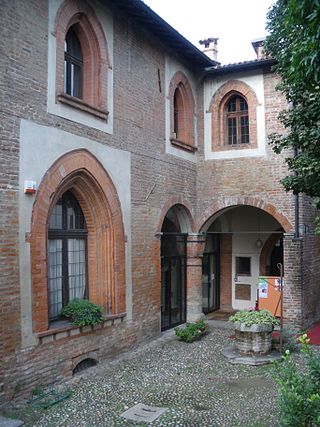
The Casa degli Eustachi is a medieval palace in Pavia in Lombardy.

The Old Campus of the University of Pavia is a complex located in Pavia, in Lombardy, home to the rectorate and some university faculties and the University History Museum of the University of Pavia.

Palazzo Mezzabarba is a palace in Pavia, Lombardy, a notable example of Lombard rococo, It has been Pavia's city hall since 1875.

The monastery of Santa Maria Teodote, also known as Santa Maria della Pusterla, was one of the oldest and most important female monasteries in Pavia, Lombardy, now Italy. Founded in the seventh century, it stood in the place where the diocesan seminary is located and was suppressed in the eighteenth century.

The Palazzo Botta or Botta Adorno is a Neoclassical-style palace with a long facade along Via Lanfranco and Piazza Botta Adorno Antoniotto in the town of Pavia, region of Lombardy, Italy. Once the family home of the aristocratic Botta family, it presently houses the Natural History Museum of Pavia and the Museum Camillo Golgi.

Palazzo Cornazzani is a palace in Pavia, in Lombardy, where, between 1895 and 1896, Albert Einstein lived.
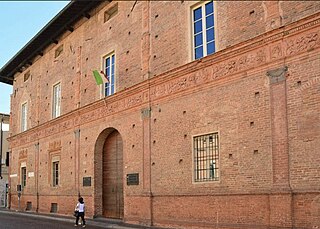
Palace Carminali Bottigella is a noble palace built by the ancient Beccaria family from Pavia. The original structure from the Sforza era was built between 1490 and 1499. The façade, which retains the original terracotta decorations, is one of the major examples of Renaissance civil building in Pavia.
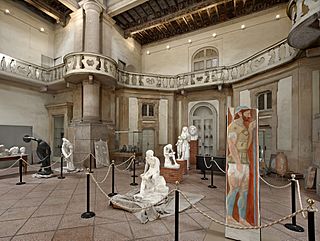
The Museum of Archeology of the University of Pavia was established in 1819 and is, together with that of Padua, one of the oldest in Italy. The museum is located inside the ancient San Matteo hospital in Pavia.







